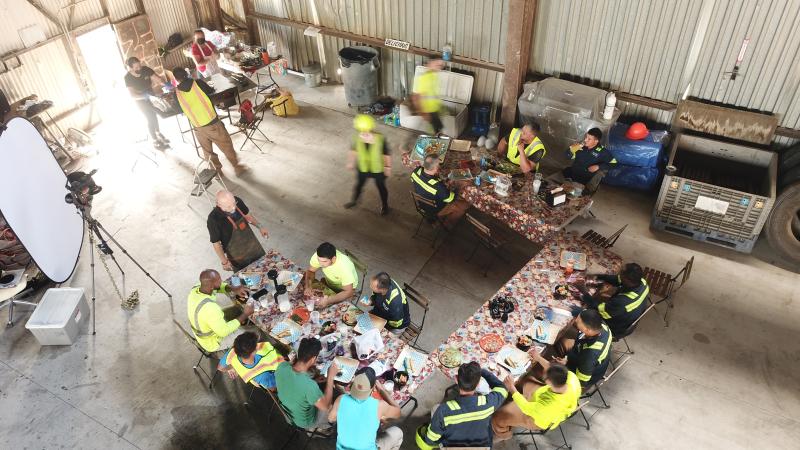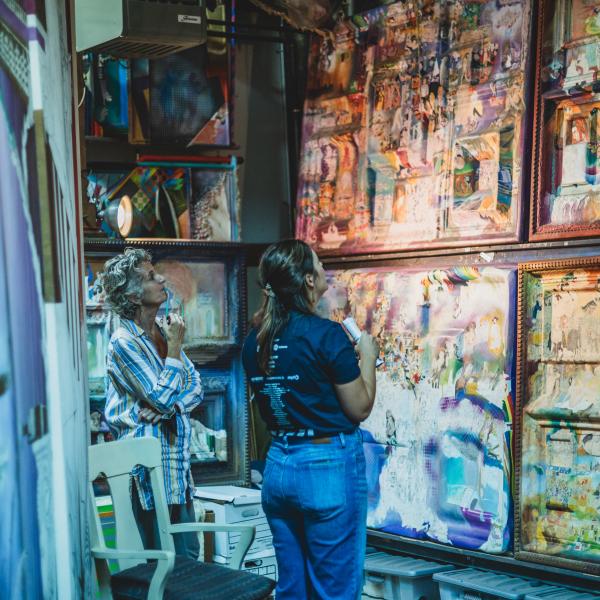From Trash to Treasure

Hsin Yu-Chen (2022 Open Call Resident) affixes a camera to an excavator claw. Photo courtesy of Recycled Artist in Residency (RAIR)
On any given day at Revolution Recovery, a 3.5-acre commercial waste facility in northeast Philadelphia, Pennsylvania, an excavator might be used to move some of the more than 550 tons of material that come through the premises daily.
That same excavator could also serve as a makeshift boom crane to capture a tracking shot for a film project, with a camera ratchet-strapped to its arm. This unorthodox use of Revolution Recovery’s equipment is facilitated by Recycled Artist in Residency (RAIR) Philly, an artist-in-residence program that has been working with the company for more than a decade. Before drone technology became available, one of RAIR’s artists used the excavator in exactly that way, with the assistance of RAIR staff and consent from the facility.
“[The recycling facility,] both in material and equipment and site, is available to be co-opted creatively, as long as we can do it in a way that is safe for both the artist, RAIR staff, and for operations,” said sculptor Billy Dufala, who is also RAIR’s co-founder and creative director.
As an emerging artist in the 2000s, Dufala was constantly salvaging materials from abandoned buildings and dumpsters—motivated primarily by economics. He was also inspired by the Recology San Francisco Artist in Residence Program, located at the San Francisco Recycling and Transfer Center. Unfortunately for Dufala, the program was only open to artists in the greater Bay area, but he dreamed of forging that kind of partnership somewhere in Philadelphia, not only for himself but for other artists.
“I'm of the mind” he said, “that when you're pursuing something that is of interest or a potential resource, that you're doing it with paying forward to community in mind.”
In 2009, Dufala met the owner of Revolution Recovery, who then introduced him to Fern Gookin, a graduate student in sustainable design at the time.
“[Fern] pitched her thesis as starting an artist resource at their facility,” Dufala said. “And they're like ‘Oh, we know this crazy guy, Billy. You should probably talk to him.’”
Between Gookin’s thesis project and Revolution Recovery’s facilities, Dufala’s dream was realized.
RAIR was piloted for years before developing into the formalized program it is today, which consists of two residency types: the standard and the “biggie shortie.” The standard residency is a more traditional studio-based program while the biggie shortie residency prompts artists to complete a big project in a short amount of time. “By facilitating artists’ direct engagement with the waste stream, RAIR encourages residents to consider their studio practice through the lens of sustainability and to thoughtfully reassess their processes of material sourcing and waste disposal,” the RAIR website notes.
“In a lot of practices, it's making these things that you then bring back to your studio or you crate and ship and store and have to transport, or show in a museum or a gallery, or whatever,” Dufala said. “[The biggie shortie] is really about that co-opting of site materials and equipment in a way that you're experimenting. For me, it's a model that allows a lot of latitude and experimentation for artists, room to fail…. At the end of the process, once you've captured and documented that project, it can go back into the waste stream if it needs to.”
The residency is also not prescriptive to the type of art that has to come out of this engagement. Sculpture is a natural fit for a facility with hundreds of tons of interesting material to work with, but the residency has also attracted other kinds of visual artists, multidisciplinary artists creating theater or film, and two years ago, RAIR welcomed its first composer.

Karyn Olivier's installation of Sampling (need you), consisting of construction water barriers, audio amplifiers, and audio of construction zones in Philadelphia neighborhoods, at Tonya Bonakdar Gallery in 2023. Photo courtesy of Recycled Artist in Residency (RAIR)
Both residencies, as RAIR’s website states, are intended not only to stretch artists’ imaginations of what is possible with the resources available at the waste facility, they are also intended to de-mystify an often-obscured reality.
“People don't understand the back end of these systems because it's designed to mostly be invisible,” Dufala said. “I don't think that you could spend even a day in a place like this and have it not drastically impact your urgency for change in behavior, because the systems will not change unless the consumers and the behavior ask it to.”
While RAIR staff try to have as little impact as possible on operations, Dufala said the entire facility is at the disposal of artists. During her residency, artist Karen Oliver wanted to film the sort line—a conveyor belt with stations that separates waste by material type—without any of its workers. The sort line would never normally run without people on the ground, but through his relationship with operations and by compensating workers to come in on a Sunday, Dufala was able to realize Oliver’s vision without losing any material in the process.
“I think a lot of what we've done over the years in terms of building out our toolbox and our knowledge base is slowly aggregating all of these answers for artists' questions and being able to solve for questions and problems and inquiries in a way that satisfies whatever it is the artist's needs might be, but in a safe way being able to cultivate a bank of resources and potential opportunities,” Dufala said.
The workers who worked on that Sunday of Oliver’s filming were impressed by the effect of seeing a process they knew so intimately in a new light. While they try to stay out of workers’ ways as much as possible out of respect for their duties, Dufala said they do occasionally engage with RAIR’s work, whether as a target audience or as a subject of work.

Eugenio Salas prepares and serves lunch for workers at the recycling center. Photo courtesy of Recycled Artist in Residency (RAIR)
Another artist, Eugenio Salas, based his project on immigration and food—mapping cultural heritage through recipes. Using materials at the Revolution Recovery and with the help of the facility’s mechanic, Salas welded together steel to make a grill and then cooked for all of the operations staff. With the mechanic’s wife, he photographed their hands holding the food he cooked, documenting the occasion.
“People were like ‘When are you working with Eugenio again? When are you going to cook lunch again?’” Dufala said.
Due to the heavy machinery and processes taking place at Revolution Recovery, the risk and liability of bringing an artist in could be daunting, but Dufala said that “most things are possible” with mutual respect, trust, and maintenance of relationships between RAIR and operations staff.
“Not to be mistaken, we exist here because of their generosity,” Dufala said of staff at the facility. “And there's something to be said about taking that and passing that on in this kind of form of radical generosity to those we serve. I think that that's really important in this day and age as people's resources seemingly are restricted, but there's a lot more going on behind and around that challenge that perception.”








